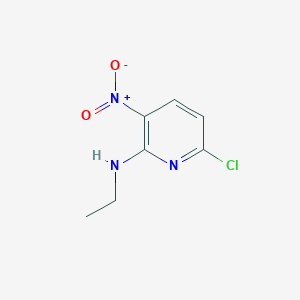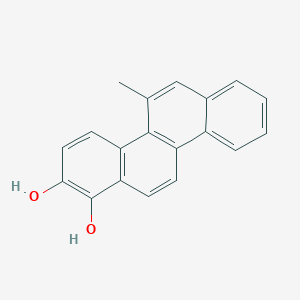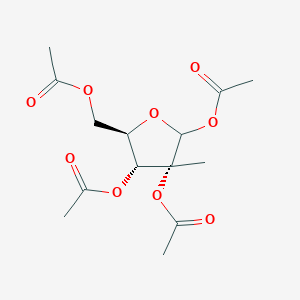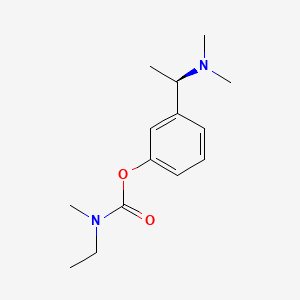
(R)-Rivastigmine
Descripción general
Descripción
®-Rivastigmine is a chiral carbamate derivative used as a medication for the treatment of mild to moderate dementia associated with Alzheimer’s disease and Parkinson’s disease. It functions as a cholinesterase inhibitor, enhancing cholinergic function by increasing the concentration of acetylcholine through reversible inhibition of its hydrolysis by cholinesterase.
Métodos De Preparación
Synthetic Routes and Reaction Conditions: The synthesis of ®-Rivastigmine typically involves the following steps:
Formation of the Chiral Intermediate: The chiral intermediate is synthesized through the reaction of ®-3-(1-dimethylaminoethyl)phenol with 3-bromopropylamine hydrobromide.
Carbamate Formation: The intermediate is then reacted with methyl isocyanate to form ®-Rivastigmine.
Industrial Production Methods: Industrial production of ®-Rivastigmine involves large-scale synthesis using optimized reaction conditions to ensure high yield and purity. The process includes:
Batch Processing: Utilizing batch reactors for the controlled addition of reagents.
Purification: Employing techniques such as crystallization and chromatography to purify the final product.
Types of Reactions:
Oxidation: ®-Rivastigmine can undergo oxidation reactions, typically in the presence of strong oxidizing agents.
Reduction: Reduction reactions can occur under specific conditions, although they are less common.
Substitution: The compound can participate in nucleophilic substitution reactions, particularly at the carbamate group.
Common Reagents and Conditions:
Oxidation: Reagents such as hydrogen peroxide or potassium permanganate.
Reduction: Reagents like lithium aluminum hydride.
Substitution: Nucleophiles such as amines or thiols.
Major Products:
Oxidation: Oxidized derivatives of ®-Rivastigmine.
Reduction: Reduced forms of the compound.
Substitution: Substituted carbamate derivatives.
Aplicaciones Científicas De Investigación
®-Rivastigmine has a wide range of applications in scientific research:
Chemistry: Used as a model compound to study cholinesterase inhibition and related mechanisms.
Biology: Investigated for its effects on neurotransmitter levels and neuronal function.
Medicine: Extensively studied for its therapeutic potential in neurodegenerative diseases.
Industry: Utilized in the development of new cholinesterase inhibitors and related pharmaceuticals.
Mecanismo De Acción
®-Rivastigmine exerts its effects by inhibiting acetylcholinesterase and butyrylcholinesterase, enzymes responsible for the breakdown of acetylcholine. By inhibiting these enzymes, ®-Rivastigmine increases the concentration of acetylcholine in the synaptic cleft, enhancing cholinergic transmission. This mechanism is particularly beneficial in conditions like Alzheimer’s disease, where cholinergic deficits are prominent.
Comparación Con Compuestos Similares
Donepezil: Another cholinesterase inhibitor used in Alzheimer’s disease.
Galantamine: A natural alkaloid with cholinesterase inhibitory properties.
Tacrine: An older cholinesterase inhibitor with a similar mechanism of action.
Comparison:
Uniqueness: ®-Rivastigmine is unique in its dual inhibition of both acetylcholinesterase and butyrylcholinesterase, whereas Donepezil primarily inhibits acetylcholinesterase.
Efficacy: Studies suggest that ®-Rivastigmine may offer benefits in patients who do not respond to other cholinesterase inhibitors.
Side Effects: The side effect profile of ®-Rivastigmine is comparable to other cholinesterase inhibitors, with gastrointestinal symptoms being the most common.
Propiedades
IUPAC Name |
[3-[(1R)-1-(dimethylamino)ethyl]phenyl] N-ethyl-N-methylcarbamate | |
|---|---|---|
| Source | PubChem | |
| URL | https://pubchem.ncbi.nlm.nih.gov | |
| Description | Data deposited in or computed by PubChem | |
InChI |
InChI=1S/C14H22N2O2/c1-6-16(5)14(17)18-13-9-7-8-12(10-13)11(2)15(3)4/h7-11H,6H2,1-5H3/t11-/m1/s1 | |
| Source | PubChem | |
| URL | https://pubchem.ncbi.nlm.nih.gov | |
| Description | Data deposited in or computed by PubChem | |
InChI Key |
XSVMFMHYUFZWBK-LLVKDONJSA-N | |
| Source | PubChem | |
| URL | https://pubchem.ncbi.nlm.nih.gov | |
| Description | Data deposited in or computed by PubChem | |
Canonical SMILES |
CCN(C)C(=O)OC1=CC=CC(=C1)C(C)N(C)C | |
| Source | PubChem | |
| URL | https://pubchem.ncbi.nlm.nih.gov | |
| Description | Data deposited in or computed by PubChem | |
Isomeric SMILES |
CCN(C)C(=O)OC1=CC=CC(=C1)[C@@H](C)N(C)C | |
| Source | PubChem | |
| URL | https://pubchem.ncbi.nlm.nih.gov | |
| Description | Data deposited in or computed by PubChem | |
Molecular Formula |
C14H22N2O2 | |
| Source | PubChem | |
| URL | https://pubchem.ncbi.nlm.nih.gov | |
| Description | Data deposited in or computed by PubChem | |
DSSTOX Substance ID |
DTXSID90194422 | |
| Record name | Rivastigmine, (R)- | |
| Source | EPA DSSTox | |
| URL | https://comptox.epa.gov/dashboard/DTXSID90194422 | |
| Description | DSSTox provides a high quality public chemistry resource for supporting improved predictive toxicology. | |
Molecular Weight |
250.34 g/mol | |
| Source | PubChem | |
| URL | https://pubchem.ncbi.nlm.nih.gov | |
| Description | Data deposited in or computed by PubChem | |
CAS No. |
415973-05-6 | |
| Record name | Rivastigmine, (R)- | |
| Source | ChemIDplus | |
| URL | https://pubchem.ncbi.nlm.nih.gov/substance/?source=chemidplus&sourceid=0415973056 | |
| Description | ChemIDplus is a free, web search system that provides access to the structure and nomenclature authority files used for the identification of chemical substances cited in National Library of Medicine (NLM) databases, including the TOXNET system. | |
| Record name | Rivastigmine, (R)- | |
| Source | EPA DSSTox | |
| URL | https://comptox.epa.gov/dashboard/DTXSID90194422 | |
| Description | DSSTox provides a high quality public chemistry resource for supporting improved predictive toxicology. | |
| Record name | RIVASTIGMINE, (R)- | |
| Source | FDA Global Substance Registration System (GSRS) | |
| URL | https://gsrs.ncats.nih.gov/ginas/app/beta/substances/Z25UDQ15MV | |
| Description | The FDA Global Substance Registration System (GSRS) enables the efficient and accurate exchange of information on what substances are in regulated products. Instead of relying on names, which vary across regulatory domains, countries, and regions, the GSRS knowledge base makes it possible for substances to be defined by standardized, scientific descriptions. | |
| Explanation | Unless otherwise noted, the contents of the FDA website (www.fda.gov), both text and graphics, are not copyrighted. They are in the public domain and may be republished, reprinted and otherwise used freely by anyone without the need to obtain permission from FDA. Credit to the U.S. Food and Drug Administration as the source is appreciated but not required. | |
Synthesis routes and methods
Procedure details






Retrosynthesis Analysis
AI-Powered Synthesis Planning: Our tool employs the Template_relevance Pistachio, Template_relevance Bkms_metabolic, Template_relevance Pistachio_ringbreaker, Template_relevance Reaxys, Template_relevance Reaxys_biocatalysis model, leveraging a vast database of chemical reactions to predict feasible synthetic routes.
One-Step Synthesis Focus: Specifically designed for one-step synthesis, it provides concise and direct routes for your target compounds, streamlining the synthesis process.
Accurate Predictions: Utilizing the extensive PISTACHIO, BKMS_METABOLIC, PISTACHIO_RINGBREAKER, REAXYS, REAXYS_BIOCATALYSIS database, our tool offers high-accuracy predictions, reflecting the latest in chemical research and data.
Strategy Settings
| Precursor scoring | Relevance Heuristic |
|---|---|
| Min. plausibility | 0.01 |
| Model | Template_relevance |
| Template Set | Pistachio/Bkms_metabolic/Pistachio_ringbreaker/Reaxys/Reaxys_biocatalysis |
| Top-N result to add to graph | 6 |
Feasible Synthetic Routes
Q1: What is unique about the synthesis method for (R)-N-ethyl-N-methyl carbamic acid-3-(1-hydroxyethyl) phenyl ester described in the research?
A1: The research highlights a novel approach to synthesizing (R)-N-ethyl-N-methyl carbamic acid-3-(1-hydroxyethyl) phenyl ester, a crucial intermediate in the production of (R)-Rivastigmine []. This method boasts high stereoselectivity, utilizing a chiral catalyst to achieve an enantiomeric excess (ee) exceeding 98% for the desired (R)-enantiomer []. Remarkably, this impressive selectivity is achieved with a remarkably low catalyst loading, requiring just 1/100,000th to 1/1,000,000th of the reactant amount []. This efficient use of the catalyst, coupled with the method's ability to achieve complete reactant conversion, underscores its potential for large-scale production of this important pharmaceutical intermediate.
Descargo de responsabilidad e información sobre productos de investigación in vitro
Tenga en cuenta que todos los artículos e información de productos presentados en BenchChem están destinados únicamente con fines informativos. Los productos disponibles para la compra en BenchChem están diseñados específicamente para estudios in vitro, que se realizan fuera de organismos vivos. Los estudios in vitro, derivados del término latino "in vidrio", involucran experimentos realizados en entornos de laboratorio controlados utilizando células o tejidos. Es importante tener en cuenta que estos productos no se clasifican como medicamentos y no han recibido la aprobación de la FDA para la prevención, tratamiento o cura de ninguna condición médica, dolencia o enfermedad. Debemos enfatizar que cualquier forma de introducción corporal de estos productos en humanos o animales está estrictamente prohibida por ley. Es esencial adherirse a estas pautas para garantizar el cumplimiento de los estándares legales y éticos en la investigación y experimentación.


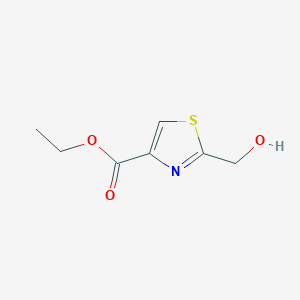
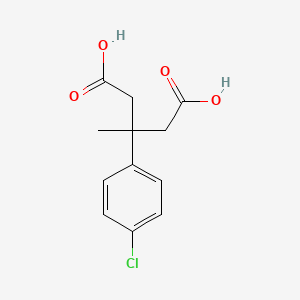
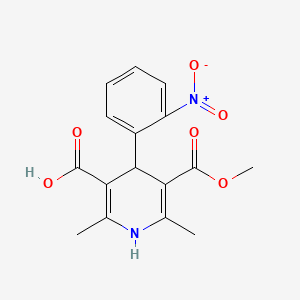

![Benzene, 1-[(chloromethyl)thio]-4-methoxy-](/img/structure/B1354781.png)
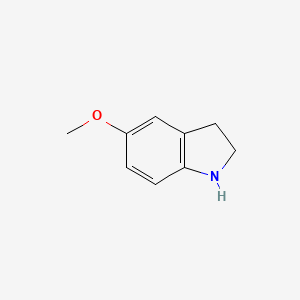
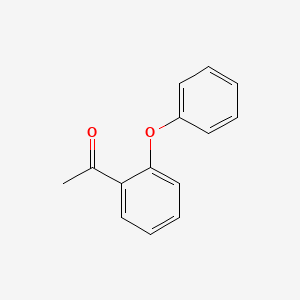
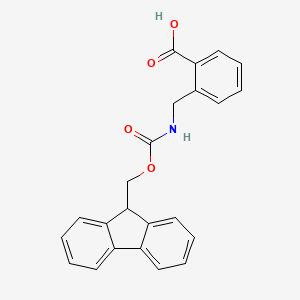
![2-hexyl-5-[5-[5-(5-hexylthiophen-2-yl)thiophen-2-yl]thiophen-2-yl]thiophene](/img/structure/B1354794.png)
